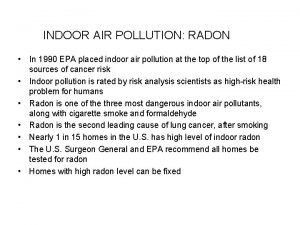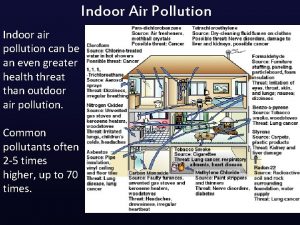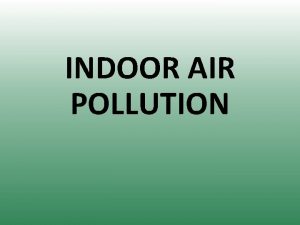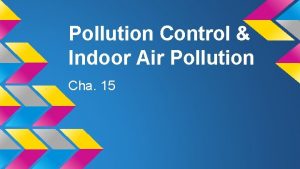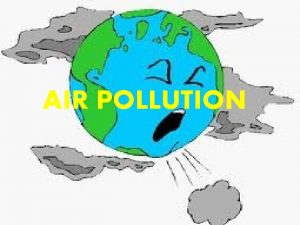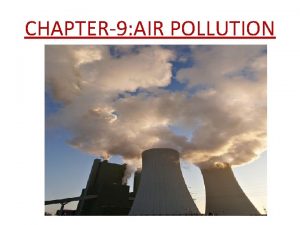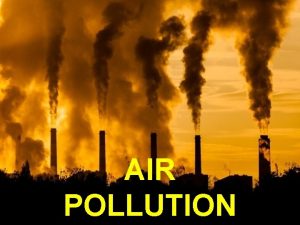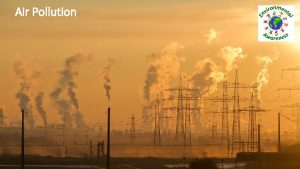Indoor Air Pollution Indoor Air Quality Indoor Air









- Slides: 9

Indoor Air Pollution

Indoor Air Quality

Indoor Air Pollution • Indoor air contains higher concentrations of pollutants than outdoor air (up to 70 x) • Indoor air pollution usually is a greater threat to human health than outdoor air pollution. – Avg. U. S. citizen spends 90% of time indoors – 6, 000 people die per day from indoor air pollution related health problems

Most dangerous indoor air pollutants • Cigarette smoke—leads to lung cancer & heart disease • Formaldehyde—colorless, extremely irritating gas used to manufacture household materials • Building materials (plywood, paneling, high-gloss wood) – Building Materials (6: 43) • Furniture • Drapes & upholstery • Adhesives in carpeting & wallpaper • Radioactive Radon-222 gas – – – Produced by the radioactive decay of uranium-238 Exposes lungs to ionizing radiation Second leading cause of lung cancer after cigarette smoking Radon (2: 06) Radon 2 (1: 28)

Most dangerous indoor air pollutants • Asbestos—especially in developing nations – – Several different forms of silicate minerals Widely used as a building material 1989—EPA ordered a ban on remaining uses of asbestos by 1997 Asbestos (2: 16) • Carbon monoxide—Faulty furnaces, stoves, fireplaces & Cigarette smoking – Causes headache, heartbeat irregularity, & carboxyhemoglobin – Carbon Monoxide (4: 44) • Organic materials—Dust mites, fungal spores, animal dander, hair, carpet fibers – Allergies, coughs, sneezing, eye irritation • Burning of wood, dung, & coal in open fires—developing nations

Developed Countries • According to the EPA, the 4 most dangerous indoor air pollutants in developed countries are: – Tobacco smoke – Formaldehyde – Radioactive radon-222 gas – Very small fine & ultrafine particles

Developing Countries • Solid particulates - from burning wood, charcoal, dung, crop waste – With little to no ventilation – Soot and carbon monoxide

Sick-Building Syndrome • A sickness produced by indoor pollution w/ general & nonspecific symptoms • persistent set of symptoms in >20% population • complaints/Symptoms relieved after exiting building • Dizziness, headaches, coughing, sneezing, nausea, & flu-like symptoms • New buildings are more commonly “sick” than old ones because of reduced air exchange. – Chemicals released from new carpet, paint and furniture – Can be solved with low-toxicity building materials & good ventilation – Sick Building Syndrome (1: 05)

Reducing Indoor Air Pollution • In developed countries: – – – – Use low-toxicity materials Monitor air quality Keep rooms clean Ban indoor smoking Prevent radon infiltration Increase intake of outside air Set stricter formaldehyde emission standards Limit exposure to chemicals • In developing countries: – Dry wood before burning – Cook outside – Use less-polluting fuels (natural gas)
 Indoor air pollution examples
Indoor air pollution examples Radon indoor air pollution
Radon indoor air pollution Prevention of indoor air pollution
Prevention of indoor air pollution Indoor air pollution sources
Indoor air pollution sources Chapter 12 section 1 what causes air pollution
Chapter 12 section 1 what causes air pollution Chapter 12 air section 1 what causes air pollution
Chapter 12 air section 1 what causes air pollution Perform quality assurance
Perform quality assurance Pmp quality vs grade
Pmp quality vs grade What are quality standards in project management
What are quality standards in project management Ana model of quality assurance
Ana model of quality assurance

